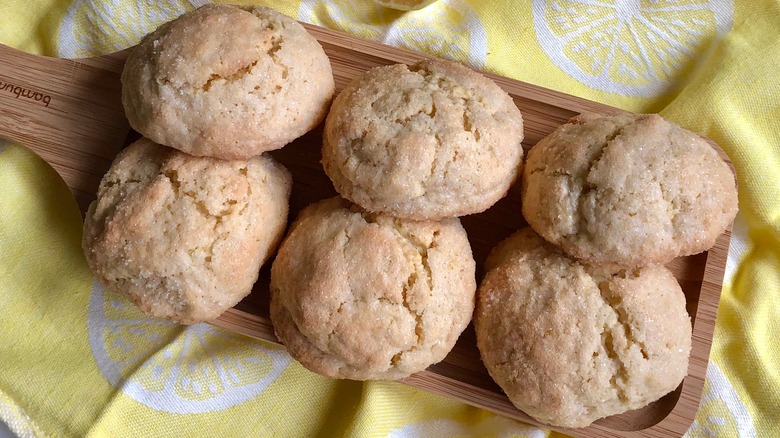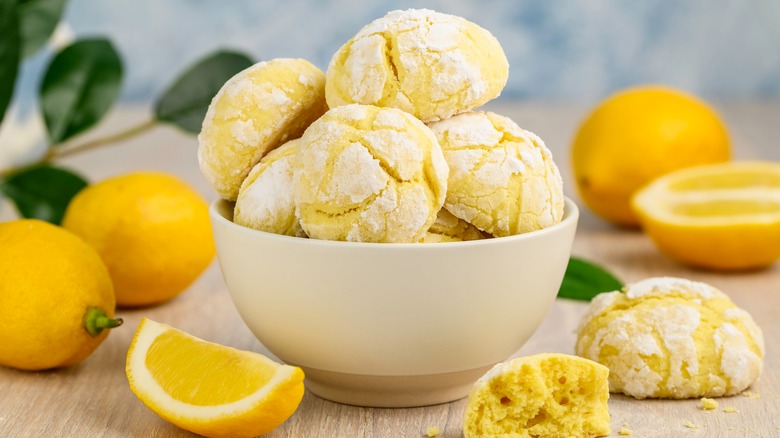The Creamy Ingredient Giada De Laurentiis Adds To Her Lemon Cookies
Although citrus is available all year, winter is the peak season for the juiciest lemons, especially Meyer lemons, a lemon and orange hybrid that are sweeter and less acidic than the traditional fruit. Giada De Laurentiis' lemony cookie is a traditional Italian favorite — one that uses ricotta cheese. Similar to recipes containing cream cheese or sour cream, ricotta adds richness to the cookie without imparting any flavor, as cream cheese would. De Laurentiis suggests using a quality full-fat ricotta made with whole milk like Galbani, which contains just three ingredients: milk, vinegar, and salt.
Thanks to ricotta, an ingredient found in many Italian desserts, Giada De Laurentiis' lemon ricotta cookies are soft and cakey like French madeleine cookies — but dipped into a bright lemon glaze that adds a sweet and slightly tart dimension. Lemon juice and zest appear in the recipe in both the cookie and glaze, so these are perfect for the lemon dessert lover in your life. If you're interested in making them, here are some tips to ensure success.
Tips for making lemon ricotta cookies
If the ricotta is very wet, strain the cheese with a fine mesh sieve to remove excess liquid. Too much moisture will flatten the cookies and make them difficult to roll. Since this is already a wet dough, it needs to chill for at least two hours or overnight to firm up before rolling, so plan ahead if you want to make this recipe.
Lemon is a prominent ingredient in this recipe, requiring the zest and juice, so it's essential to use organic lemons so the flavedo (outer layer) doesn't contain harmful pesticides or petrochemicals, which are difficult to rinse off. Lemons are coated in wax to keep the fruit from prematurely rotting, so unwaxed organic fruit would be the best option for any recipe requiring zest.
We also recommend using fresh lemon juice (three tablespoons, according to Giada De Laurentiis), not bottled stuff, which doesn't have the same lemony brightness. The zest contains the fruit's essential oils and has a concentrated lemon flavor. When zesting, Giada De Laurentiis suggests avoiding the white pith, which is bitter, and only removing the thin yellow skin. Just remember to zest before you juice.
Lemon ricotta cookies are pale even when fully baked. Before glazing, allow the cookies to cool completely, or the glaze will absorb into the cookie instead of capping it. Lemon zest adds yellow speckles to the glaze — however, some bakers like to adorn the tops with rainbow non-perils — especially in the spring.
Storing your lemon cookies and using extra ricotta
Allow the glaze to set for at least two hours to give it time to harden. The cookies can be stored in an airtight container in the refrigerator for up to a week. Stacking the cookies prematurely will cause them to stick together, leaving the bottom cookie without glaze.
Unglazed cookies can be frozen for a few months. Once defrosted, dip the cookies in the glaze or spoon some over them, allowing gravity to spread it. If garnishing with non-perils, sprinkle them while the glaze is still wet, so they adhere.
If you are wondering what to do with the rest of the ricotta, we've got a host of delicious recipes using the creamy cheese. Honey-glazed figs with lemon ricotta are a simple dessert to throw together in a pinch. Or try an Italian cheesecake made with ricotta and mascarpone cheese.
For savory dishes, you can't go wrong with placing whipped ricotta under just about any pasta dish you make, but it's particularly decadent with a simple Pomodoro sauce. Season the ricotta with kosher salt, freshly ground black pepper, fresh herbs, and spicy red pepper flakes for a creamy addition. Or top sliced, toasted crostini with whipped ricotta and drizzle with honey for a crowd-pleasing appetizer.



